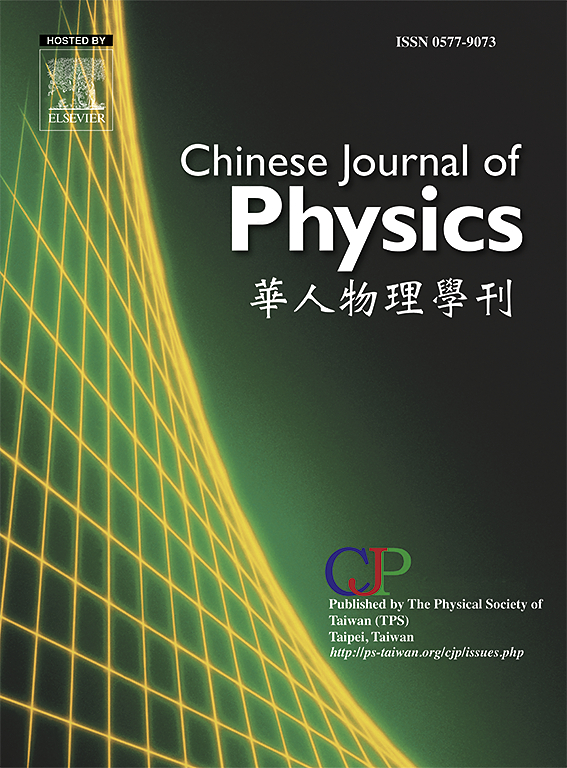Electroosmosis modulated physiological fluid propulsion through a non-uniform peristaltic microchannel in bio-microfluidic environment
IF 4.6
2区 物理与天体物理
Q1 PHYSICS, MULTIDISCIPLINARY
引用次数: 0
Abstract
The present work deals with the mathematical modeling of electroosmosis-aided creeping hydrodynamic propulsion of couple stress fluid due to the combined interaction of electroosmosis and peristalsis mechanisms inside a non-uniform porous microchannel under the influence of an imposed electric field. This model is an estimation of embryological fluid transport through a human uterus where an electric field is applied to induce the artificial fluid transport inside the uterus. Here, walls of the non-uniform microchannel are considered with a surface roughness of a sinusoidal pattern. This flow situation is modeled with the help of the equation of continuity, the momentum balance equation, and the Poisson equation. These governing equations are simplified under the lubrication approximation and Debye–Hückel approximation and solved in MATHEMATICA software for the velocity and electric potential function for exploring the kinematics of the considered flow system. Furthermore, the present model is validated with the available scientific literature to ensure its reliability. Illustrative figures are sketched to investigate the impact of physical parameters such as non-uniformity of the channel, surface roughness, electroosmotic velocity, Debye–Hückel parameter, occlusion, Darcy number, and couple stress parameter on the hydrodynamic quantities. To incorporate the fluid trapping effect and visualize the flow pattern inside the non-uniform microchannel, streamline plots are also sketched for sinusoidal waveforms along with other types of waveforms. This research work is applicable in gaining insights about the physiological propulsion in the human uterus due to fluid–structure interaction, as well as in developing artificial organs, bio-microfluidic devices, and lab-on-a-chip systems.

电渗透法在生物微流体环境中通过非均匀的蠕动微通道调节生理流体推进
本文研究了在外加电场作用下,非均匀多孔微通道内电渗透和蠕动机制共同作用下,电渗透辅助耦合应力流体蠕变水动力推进的数学模型。该模型是通过施加电场诱导子宫内人工液体输送的人体子宫胚胎液输送的估计。这里,非均匀微通道的壁被认为具有正弦模式的表面粗糙度。利用连续性方程、动量平衡方程和泊松方程对这种流动情况进行了建模。这些控制方程在润滑近似和debye - h ckel近似下进行了简化,并在MATHEMATICA软件中求解速度和电势函数,以探索所考虑的流动系统的运动学。此外,利用现有的科学文献对模型进行了验证,以确保其可靠性。为了研究通道的不均匀性、表面粗糙度、电渗透速度、debye - h ckel参数、遮挡、达西数和耦合应力参数等物理参数对水动力量的影响,绘制了说明性图。为了结合流体捕获效应和可视化非均匀微通道内的流动模式,还绘制了正弦波形和其他类型波形的流线图。本研究工作可应用于了解人子宫在流固相互作用下的生理推进,以及人工器官、生物微流控装置和芯片实验室系统的开发。
本文章由计算机程序翻译,如有差异,请以英文原文为准。
求助全文
约1分钟内获得全文
求助全文
来源期刊

Chinese Journal of Physics
物理-物理:综合
CiteScore
8.50
自引率
10.00%
发文量
361
审稿时长
44 days
期刊介绍:
The Chinese Journal of Physics publishes important advances in various branches in physics, including statistical and biophysical physics, condensed matter physics, atomic/molecular physics, optics, particle physics and nuclear physics.
The editors welcome manuscripts on:
-General Physics: Statistical and Quantum Mechanics, etc.-
Gravitation and Astrophysics-
Elementary Particles and Fields-
Nuclear Physics-
Atomic, Molecular, and Optical Physics-
Quantum Information and Quantum Computation-
Fluid Dynamics, Nonlinear Dynamics, Chaos, and Complex Networks-
Plasma and Beam Physics-
Condensed Matter: Structure, etc.-
Condensed Matter: Electronic Properties, etc.-
Polymer, Soft Matter, Biological, and Interdisciplinary Physics.
CJP publishes regular research papers, feature articles and review papers.
 求助内容:
求助内容: 应助结果提醒方式:
应助结果提醒方式:


